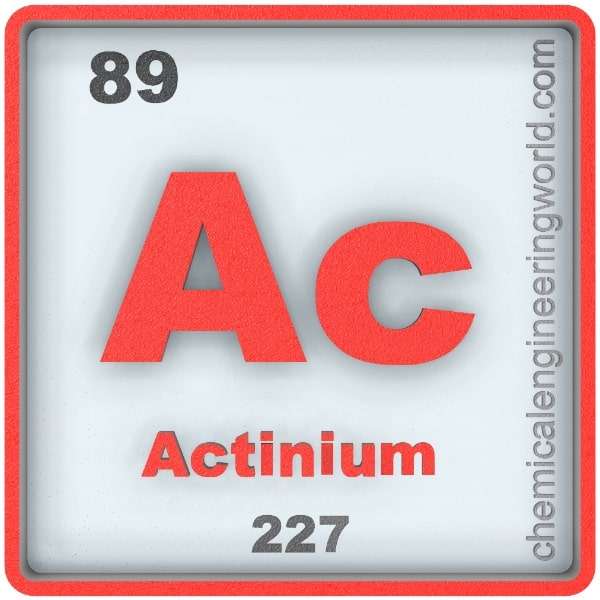Actinium Element Properties and Information

Actinium Element Properties and Information
Actinium is 89th element on the periodic table. Elements are arranged in the periodic table on the basis of the atomic number. Atomic number is the number of protons in the nucleus of the atom. Actinium has an atomic number of 89. It is located in the Group ‘Actinides’ and Period 7 of the periodic table of elements. It is denoted by the symbol ‘Ac’. The name is derived from the Greek word ‘Actinos’ which means ‘Ray’.
André Debierne is credited as the discoverer of Actinium after he extracted it from uranium ore pitchblende in 1899. Friedrich Otto Giesel also extracted the same metal from a similar mineral in 1902: he named it Emanium because he did not know that it was an already discovered element. Actinium is naturally found only in trace amounts in the uranium ores. About 0.2 mg of actinium is contained within 1 ton of uranium ore.
Physical Properties
- Actinium is a soft, silvery-white, radioactive, metallic element which glows in the dark with a pale-blue light.
- The atomic mass of actinium is 227.
- The melting point of actinium is 1050°C.
- The boiling point of actinium is 3250°C.
- The density of actinium is 10700 in S.I. units at 20°C.
- The estimated shear modulus of actinium is similar to that of lead.
- Naturally occurring actinium is composed of 2 isotopes; actinium-227 and actinium-228.
Chemical Properties
- Actinium reacts with oxygen and moisture to form a white colour oxide.
- Actinium chemistry is difficult to study due to its radioactivity.
- Actinium is observed to form oxides, halides, oxyhalides, and oxophosphates.
Methods of Production
Irradiation: The radium-226 is irradiated with neutron in a nuclear reactor to form actinium-227. Some of the actinium-227 then catches neutrons to form actinium-228. Actinium is separated from other products using a solvent extraction process set at pH = 6.0, the solvent used is thenoyltrifluoroacetone-benzene.
Relevance in Chemical & Related Industries
Actinium has no industrial use
Relevance in Other Industries
- Medicine: Actinium is used to help treat cancer in two ways; either as a reusable generator or as a direct agent in radiation therapy.
- Measurement: Actinium is used as a part of neutron probe which detects the quantity of water in soil and also, to measure moisture for quality control during highway construction.
- Modeling: Actinium-227 has a half-life of 21.77 years which makes it convenient to be used in modelling of the vertical mixing of the slow oceanic water. Velocity analysis does not give as accurate of a result as study of concentration-depth profile.
Health Effects on Exposure
Radioactivity: Actinium is highly radioactive due to which it should be handled with care and only by experts and trained professionals. Not handling it with care can harm the cells like any other radioactive material. Harm caused by radioactivity damages the genepool and affects generations to come.
Effects on Surroundings
- Accumulation: Minute & gross releases of actinium in the environment pose a threat of accumulation & magnification in the food-chain. Food-chain links plants, animals, humans together. Thus, mis-disposal is dangerous for whole of life.
References:
https://en.wikipedia.org/wiki/Actinium
































